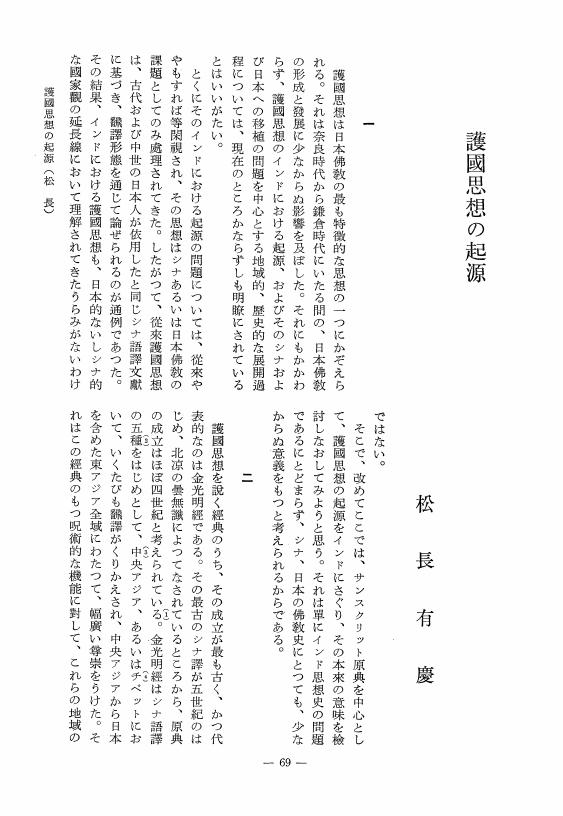1 0 0 0 泉涌寺仏牙舎利と請来者湛海について
- 著者
- 大谷 由香
- 出版者
- 日本印度学仏教学会
- 雑誌
- 印度學佛教學研究 (ISSN:00194344)
- 巻号頁・発行日
- vol.62, no.2, pp.747-752, 2014
1 0 0 0 沢庵禅師の柔術思想への影響について
- 著者
- 笠井 哲
- 出版者
- 日本印度学仏教学会
- 雑誌
- 印度學佛教學研究 (ISSN:00194344)
- 巻号頁・発行日
- vol.57, no.1, pp.122-128, 2008
1 0 0 0 沢庵『不動智』の諸武術への影響について
- 著者
- 笠井 哲
- 出版者
- 日本印度学仏教学会
- 雑誌
- 印度學佛教學研究 (ISSN:00194344)
- 巻号頁・発行日
- vol.64, no.2, pp.639-645, 2016
1 0 0 0 OA J. W. ドゥ ヨング著 オランダのインド學・佛教學
- 著者
- 湯山 明
- 出版者
- Japanese Association of Indian and Buddhist Studies
- 雑誌
- 印度學佛教學研究 (ISSN:00194344)
- 巻号頁・発行日
- vol.14, no.1, pp.382-359, 1965-12-25 (Released:2010-03-09)
1 0 0 0 OA 高句麗における仏塔の受容と展開について -文化的背景を中心に-
- 著者
- 金 春鎬
- 出版者
- Japanese Association of Indian and Buddhist Studies
- 雑誌
- 印度學佛教學研究 (ISSN:00194344)
- 巻号頁・発行日
- vol.54, no.1, pp.534-531,1288, 2005-12-20 (Released:2010-03-09)
When thinking of pagodas in Koguryo, the first question that comes to mind is where the first pagoda can be found. Also, the origin of the characteristics of Koguryo's pagodas is a problem. For example, what is the history of the one pagoda-three image hall pattern (一塔三金堂式) in the composition of Buddhist temple, and what the background of the the octagonal shape of the pagoda? In this paper I emphasize the fact that the cultural background of the characteristics of pagodas in Koguryo can be found in Koguryo's ancient tombs.
1 0 0 0 OA 浄意法師について -特に宇都宮氏と証空の関係から-
- 著者
- 野村 恒道
- 出版者
- Japanese Association of Indian and Buddhist Studies
- 雑誌
- 印度學佛教學研究 (ISSN:00194344)
- 巻号頁・発行日
- vol.30, no.1, pp.154-155, 1981-12-31 (Released:2010-03-09)
1 0 0 0 OA 世界の終末と最高神
- 著者
- 井上 信生
- 出版者
- Japanese Association of Indian and Buddhist Studies
- 雑誌
- 印度學佛教學研究 (ISSN:00194344)
- 巻号頁・発行日
- vol.45, no.1, pp.486-482, 1996-12-20 (Released:2010-03-09)
- 被引用文献数
- 1 1
1 0 0 0 OA 三経義疏の語法
- 著者
- 石井 公成
- 出版者
- 日本印度学仏教学会
- 雑誌
- 印度學佛教學研究 (ISSN:00194344)
- 巻号頁・発行日
- vol.57, no.1, pp.530-524, 2008-12-20 (Released:2017-09-01)
1 0 0 0 OA 親鸞の肉食観-『浄肉文』を通して-
- 著者
- 吉田 宗男
- 出版者
- Japanese Association of Indian and Buddhist Studies
- 雑誌
- 印度學佛教學研究 (ISSN:00194344)
- 巻号頁・発行日
- vol.45, no.2, pp.577-580, 1997-03-20 (Released:2010-03-09)
1 0 0 0 OA 護國思想の起源
- 著者
- 松長 有慶
- 出版者
- Japanese Association of Indian and Buddhist Studies
- 雑誌
- 印度學佛教學研究 (ISSN:00194344)
- 巻号頁・発行日
- vol.15, no.1, pp.69-78, 1966-12-25 (Released:2010-03-09)
1 0 0 0 OA 聖徳太子における生死の問題
- 著者
- 武田 賢壽
- 出版者
- Japanese Association of Indian and Buddhist Studies
- 雑誌
- 印度學佛教學研究 (ISSN:00194344)
- 巻号頁・発行日
- vol.14, no.1, pp.233-237, 1965-12-25 (Released:2010-03-09)
1 0 0 0 OA ウルドゥー古典詩人の雅号に関する一考察
- 著者
- 鈴木 斌
- 出版者
- Japanese Association of Indian and Buddhist Studies
- 雑誌
- 印度學佛教學研究 (ISSN:00194344)
- 巻号頁・発行日
- vol.38, no.1, pp.336-341, 1989-12-20 (Released:2010-03-09)
- 参考文献数
- 1
1 0 0 0 入宋僧俊芿と南都戒律復興運動
- 著者
- 大谷 由香
- 出版者
- 日本印度学仏教学会
- 雑誌
- 印度學佛教學研究 (ISSN:00194344)
- 巻号頁・発行日
- vol.65, no.2, pp.605-611, 2017
<p>The monk Shunjō 俊芿 (1166–1227) studied in the Southern Song for 12 years. Before studying abroad he studied Tendai in Japan. Shunjō introduced the Tendai Perfect Precepts (Enkai 円戒) to the Southern Song Buddhist community. In the Tendai ordination, the question-and-answer of whether it is possible for one to uphold the three-fold <i>śīla</i> is the formal act (<i>karman</i>). That method was called the three-fold acts (<i>sanju konma</i> 三聚羯磨). Unexpectedly, the Tendai Perfect Precepts were accepted in the Southern Song Buddhist community. After Shunjō returned to Japan, the three-fold act was adopted as the Nara Buddhist ordination, upon which Kakujō 覚盛 (1194–1249) transformed the method of Tendai ordination into the <i>tsūju</i> 通受 or comprehensive ordination of Nara Buddhism. </p>
1 0 0 0 泉福寺本『正法眼蔵聞書抄』の諸問題 -「坐禅儀聞書抄」を中心に-
- 著者
- 西尾 勝彦
- 出版者
- JAPANESE ASSOCIATION OF INDIAN AND BUDDHIST STUDIES
- 雑誌
- 印度學佛教學研究 (ISSN:00194344)
- 巻号頁・発行日
- vol.52, no.2, pp.545-548, 2004
- 著者
- 西尾 勝彦
- 出版者
- JAPANESE ASSOCIATION OF INDIAN AND BUDDHIST STUDIES
- 雑誌
- 印度學佛教學研究 (ISSN:00194344)
- 巻号頁・発行日
- vol.51, no.1, pp.179-181, 2002
- 著者
- 柏原 信行
- 出版者
- JAPANESE ASSOCIATION OF INDIAN AND BUDDHIST STUDIES
- 雑誌
- 印度學佛教學研究 (ISSN:00194344)
- 巻号頁・発行日
- vol.31, no.2, pp.884-881, 1983
1 0 0 0 OA Vasubandhu 研究ンート (1)
- 著者
- 松田 和信
- 出版者
- Japanese Association of Indian and Buddhist Studies
- 雑誌
- 印度學佛教學研究 (ISSN:00194344)
- 巻号頁・発行日
- vol.32, no.2, pp.1042-1039, 1984-03-25 (Released:2010-03-09)
1 0 0 0 三つのラサ・ネワール小説
- 著者
- 吉崎 一美
- 出版者
- 日本印度学仏教学会
- 雑誌
- 印度學佛教學研究 (ISSN:00194344)
- 巻号頁・発行日
- vol.65, no.1, pp.440-435, 2016
<p>Dharmaratna "Yami" published <i>Saṃdeyā Lisaḥ </i>(Tibet's reply) in N.S. 1072 (V.S. 2008, that is, 1952). In his novel, "Yami" censured on behalf of Tibetans not only Sāhus (employers, Newar merchants in Lhasa) for their oppression of their employees and Tibetan ladies, but also Nepal herself for her sweating Tibetans to take a large profit. Cittadhar "Hṛdaya" published his novel <i>Miṃ Manaḥ Pau </i>(Ashes of a letter) in N.S. 1088, as if he were a protector or spokesman for Sāhus and Nepal herself. Prior to these two novels written in the Newari language, Lakṣmī Prasād Devakoṭā published <i>Mun</i>ā<i>madan</i> written in the Nepali language in V.S. 1992/1996. It is the best selling book in Nepal, even now. Faced with its great popularity, "Yami" and "Hṛdaya" published their novels to protect their mother language and to maintain their own culture. </p>
1 0 0 0 OA 象徴的寓話に示されたイスラームによる「ヨーガ」の理解
- 著者
- 榊 和良
- 出版者
- Japanese Association of Indian and Buddhist Studies
- 雑誌
- 印度學佛教學研究 (ISSN:00194344)
- 巻号頁・発行日
- vol.58, no.3, pp.1139-1143, 2010-03-25 (Released:2017-09-01)
『アムリタクンダ』は,既に明らかにしたように,カーマルーパの女神をめぐるマントラを伴う祈願法と,『シヴァスヴァローダヤ』に代表されるナータ派文献にも含まれる呼吸を観察することによる占術を含むタントラ・ヨーガ文献である.13世紀末から14世紀中頃にアラビア語・ペルシア語に訳され,16世紀中頃にはインドのシャッターリー教団のスーフィーの手でイスラーム色を濃くした形でペルシア語で重訳され,中央アジアからトルコ,西アジアからマグリブ世界まで広く伝搬した理由は,寓意文学やその解釈学を発展させたイスラームの伝統を受け継いだ枠物語にある.それは,『トマス行伝』に含まれる「真珠の歌」やイフワーヌッサファー(純粋なる心をもった兄弟)と呼ばれる学者集団による『百科全書』に示された小宇宙観などの影響のもとに,中世イランの哲学者イブン・スィーナーの系譜を継いだスフラワルディーによる『愛の真実に関する論攷』に含まれる「愛」の語る物語を模している.異邦の地への旅を経ての故郷への帰還と「生命の水」による新たな生まれ変わりを核とした寓意的物語を枠として,大宇宙と小宇宙の相即性から説き起こし,「息の学」を媒介として,浄化法やチャクラへの瞑想法をとりこみつつ,本来の自己の認識による救済をめざすありかたが示される.人間の肉体をひとつの町として描き出す枠物語の示す象徴世界は『ゴーラク語録』にも共通性が見出されるが,『ゴーラクシャシャタカ』大本のペルシア語訳にも示されるように,ナータ派文献に示されるヨーガは,霊智による救済を獲得する手段としてスーフィー道と共通性をもつものと理解され,『アムリタクンダ』の翻訳者は,グノーシス的枠物語によって有資格者のためのイニシエーションとして視覚化して見せてくれたのである.
1 0 0 0 OA 古代インドにおけるアルコール関連の精神医学的問題
- 著者
- 森口 眞衣
- 出版者
- 日本印度学仏教学会
- 雑誌
- 印度學佛教學研究 (ISSN:00194344)
- 巻号頁・発行日
- vol.60, no.2, pp.850-845, 2012-03-20 (Released:2017-09-01)









